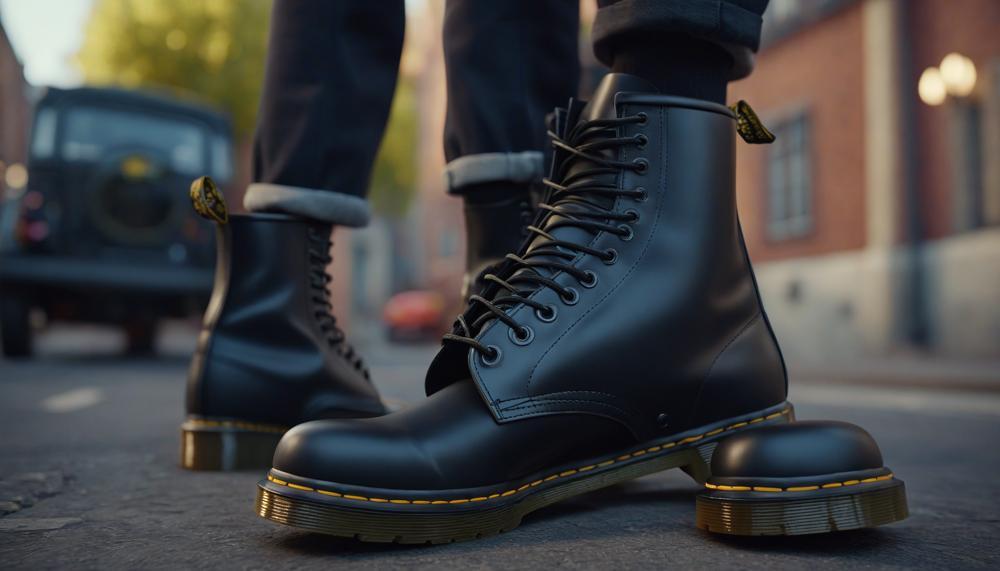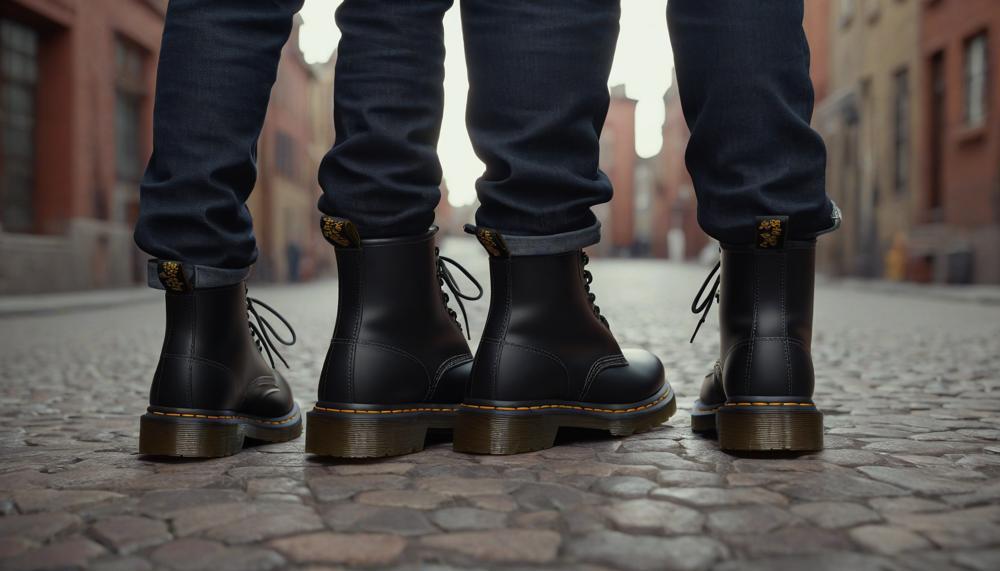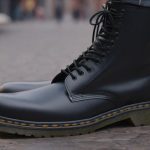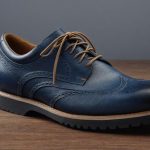Are Doc Martens good for snow? If you’re considering footwear for snowy conditions, Doc Martens can indeed be a reliable choice, thanks to their specialized designs tailored for winter wear. Unlike their classic models primarily known for their iconic style, Doc Martens offers specific lines equipped to handle cold, wet, and icy environments.
Doc Martens’ winter boots, such as those in the WinterGrip and WarmWair lines, are crafted with practical features essential for snowy weather. These boots often feature:
- Water-resistant leathers: Protect against moisture and snow.
- Fleece or faux fur linings: Provide warmth and comfort in cold temperatures.
- Enhanced traction soles: Designed to prevent slipping on icy surfaces.
These attributes make Doc Martens suitable not just for everyday wear in winter but also for activities like walking and hiking in snowy conditions. The combination of robust materials, insulated linings, and reliable grip ensures that your feet stay warm, dry, and stable, even when navigating challenging terrains.
Whether you’re commuting in the city or exploring snowy trails, Doc Martens winter boots offer a blend of style and functionality that caters to practical needs without compromising on comfort or durability. Stay tuned to explore more about why these boots provide an advantage over other products
Doc Martens Aren’t Specifically Designed For Snow
Contents
Doc Martens aren’t specifically crafted for snowy conditions because their classic design focuses on street and work wear, not extreme weather. However, for those seeking footwear suited for winter, the brand has developed specific lines addressing these needs.
The standard Doc Martens are known for their durable leather and sturdy construction, which makes them great for everyday use but not ideal for snowy environments. This is primarily due to three factors: insulation, water resistance, and traction.
- Insulation: Traditional Doc Martens lack sufficient insulation, necessary to keep feet warm in cold weather. While the leather provides some protection against the elements, it’s not enough for prolonged exposure to snow and icy conditions.
- Water Resistance: The classic leather upper is not fully waterproof, which is a critical requirement in snowy weather to prevent the boots from becoming waterlogged and cold, potentially leading to discomfort and frostbite in freezing temperatures.
- Traction: Standard Doc Martens soles are designed for general use and do not offer the enhanced grip needed on ice and snow, which can increase the risk of slips and falls.
For those who love the Doc Martens style but need appropriate footwear for winter, the brand offers specialized versions, such as the 2976 Wintergrip Chelsea Boot. These models come with modifications like water-resistant materials, WarmWair insulation for heat retention, and GripWair soles for superior traction in icy conditions.
Table of Suitable Doc Martens for Snowy Conditions:
| Model | Key Features | Suitable For |
| 2976 Wintergrip Chelsea Boot | Water-resistant, salt-resistant, GripWair technology | Snow and ice |
| Chelsea boots with Blizzard Leather | WarmAir, Snowtex lining | Wet and slippery conditions |
| Pascal’s boots with Valor WP leather | WarmWair insulation, PVC soles | Winter weather |
In conclusion, while standard Doc Martens are not designed for snowy weather due to lack of sufficient insulation, waterproofing, and specialized traction, the brand does offer models equipped with these necessary features, making them suitable for winter conditions.
For Shoes To Work In Snow, They Must Meet Four Criteria
For shoes to work in snow, they must meet four criteria, particularly for Doc Martens:
| Criteria | Details | Doc Martens Features |
| Warmth and Insulation | Ensure feet stay warm and dry in cold conditions | Faux fur or thermal fleece linings |
| Traction and Slip-Resistance | Prevent slipping on icy surfaces | Wintergrip range with enhanced grip technology |
| Durability | Withstand harsh winter elements | Robust construction typical of Doc Martens |
| Proper Care | Maintain effectiveness and longevity | Regular waterproofing and choosing suitable models |
By adhering to these criteria, you can ensure that your Doc Martens are not only stylish but also practical for snowy conditions.
The Doc Martens Limited Waterproof Slip-Resistant Range
The Doc Martens Limited Waterproof Slip-Resistant Range is particularly well-suited for snowy conditions due to its carefully crafted features designed to provide both warmth and stability in winter environments. Here’s a breakdown of the key attributes that make these boots a smart choice for snowy weather:
| Feature | Description | Benefit |
| Waterproofing | Kaya Nubuk leather paired with a DryWear waterproof membrane. | Keeps feet dry and protected from snow and melting ice. |
| Insulation | WarmAir and Snowtex fleece lining. | Provides warmth in freezing temperatures, ensuring comfort and reducing the risk of cold-related discomfort. |
| Traction | GripWair technology on the soles. | Offers superior grip on slippery and icy surfaces, minimizing the risk of falls. |
| Design | Elasticated gussets. | Enhances fit and prevents cold air and snow from entering the boots. |
These boots are a sterling pick for anyone braving the winter chill, blending the iconic rugged style of Doc Martens with functional enhancements that meet the demands of snowy landscapes. Whether trudging through city slush or taking a brisk walk in the country, these boots stand out for their robust build and reliable performance.
Are Doc Martens Good For Winter?
Doc Martens boots are iconic in style but vary in their suitability for winter conditions, particularly when dealing with snow. The traditional models, while robust, are not specifically designed for snowy environments. However, certain styles within the Doc Martens range are better equipped for cold and snowy conditions.
| Boot Model | Features | Suitability for Snow |
| Trinity Slip Resistant | Waterproof, enhanced traction | Good for moderate snow |
| Chelsea Boots with Blizzard Leather and WarmWair | Insulation, GripWear technology | Excellent for cold and wet conditions |
| 2976 Wintergrip Chelsea Boot | Water-resistant, salt-resistant, GripWair technology | Excellent for heavy snow and slush |
For light snowfall, the Pascal boots may suffice, but they are not recommended for heavier, sludgy conditions. On the other hand, the 2976 Wintergrip Chelsea Boot and the Chelsea Boots with Blizzard Leather and WarmWair insulation are highly recommended for more severe winter conditions, thanks to their advanced features like water-resistance, salt-resistance, and specialized soles for better grip.
So, while Doc Martens can handle brief walks through snow with certain models, they are not universally ideal for prolonged exposure to harsh winter conditions unless specifically designed for it, such as the models mentioned above.
How To Waterproof Your Boots For Wet, Snowy Days
To ensure your Doc Martens are fully prepped for snowy days, employing a combination of waterproofing sprays, waxes, or specific conditioners like Wonder Balsam is ideal. Here’s a detailed guide to waterproofing these iconic boots effectively:

Cleaning Before Waterproofing
Before applying any waterproofing treatments, clean your boots thoroughly. This removes any dirt and debris that could hinder the absorption of waterproofing agents.
Choosing Your Waterproofing Product
- Waterproofing Sprays: Ideal for a quick, easy application, sprays create a breathable layer of protection against moisture.
- Waxes: Provide a thicker barrier on the leather, suitable for harsher weather conditions.
- Wonder Balsam: This product nourishes the leather and adds a water-resistant top layer.
Application Process
Apply your chosen product evenly over the surface of the boots. For sprays, hold the can approximately 6 inches away from the boots and spray in a well-ventilated area. When using waxes or balsam, apply with a clean cloth or sponge, ensuring an even coat.
- Drying and Reapplication
Allow the boots to dry naturally away from direct heat sources. Reapply the product as necessary, depending on exposure to elements and frequency of use.
Post-Treatment Care
Regularly clean and reapply waterproofing treatments to maintain optimal protection throughout the winter months.
Comparison of Waterproofing Methods:
| Method | Advantages | Disadvantages |
| Waterproofing Sprays | Easy to apply, dries quickly | May require frequent reapplication |
| Waxes | Provides a durable layer, enhances lifespan | Can alter the boot’s color and texture |
| Wonder Balsam | Conditions and waterproofs, preserving leather flexibility | Less effective in heavy snow without reapplication |
Conclusion
In conclusion, while classic Doc Martens are renowned for their durability and iconic style, they fall short when it comes to handling snowy conditions effectively. The standard models lack sufficient insulation, waterproofing, and specialized traction needed to navigate icy terrains safely and comfortably. However, Doc Martens offers specialized winter boots like the 2976 Wintergrip Chelsea Boot and the Chelsea Boots with Blizzard Leather and WarmWair lining, specifically designed to meet these challenges.
These winter-specific models are equipped with water-resistant materials, WarmWair insulation for warmth, and GripWair technology for enhanced traction on slippery surfaces. This combination makes them suitable choices for those seeking both style and functionality in colder climates.
Therefore, while Doc Martens as a brand are not inherently designed for snow, their winter boot offerings cater well to snowy and icy conditions, providing the necessary features to keep your feet warm, dry, and stable.






